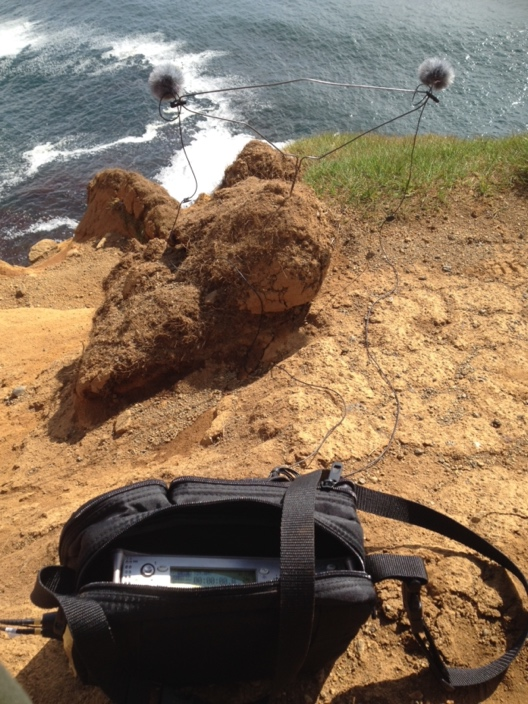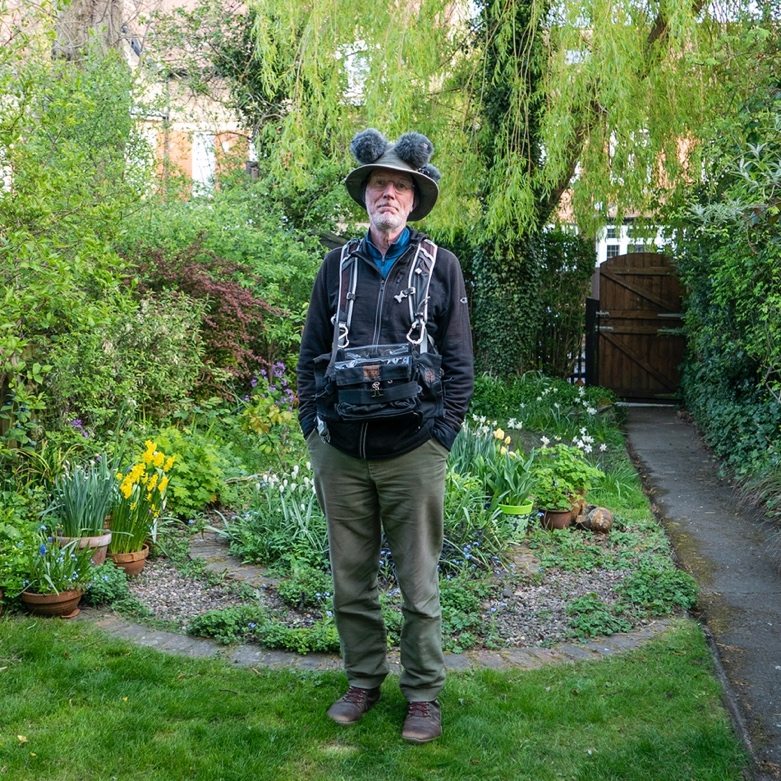Appendix C. Walking sound recording; learning by doing
In order to create my works as I imagined them, I needed to be able to record ambient sound whilst walking, alone, over extended distances, and extended periods of time.
Around May 2012 I bought a small handheld stereo Olympus LS100 sound recorder and, like many before me, discovered both the potential of recording sounds and the technical challenges of doing it. At that time I could find no advice about how to record sound whilst walking and so had to set about evolving my own method of doing so. Initially, I just walked holding the recorder in my hand, from which I quickly learnt that to be able to use the recorder whilst walking, I had to deal with the noise of wind hitting the exposed microphones, and handling noise, the vibrations transmitted from my hand whilst holding it.
As I walk, air moving is a fact of life in my practice, a subject of aesthetic interest and a phenomenon exacerbated by my own bodily movement and the positioning of the microphones I use; this makes it a significant technical challenge. Recording whilst moving in, and irrespective of, moving air is very unusual. Sound artists working in the wind are uncommon and for those that have, the resulting pieces usually form only a small part of their output.1 To prevent distorting wind roar across a microphone or popping from sudden pressure changes, microphones are protected from wind by various types of surrounding material. As a first step you can use a coat of synthetic fur that acts to slow the air (called a windjammer); a next level of protection involves placing the microphone inside a frame that provides a still-air gap around the microphone; this is in turn protected with a cover of synthetic fur.
My initial attempts with the proprietary windjammer that was sold for the Olympus LS100 was my first occasion of discovering that proprietary wind protection is never enough if you want to use microphones whilst moving. For the Olympus LS100 I evolved a method of protecting the recorder from wind and carrying it (below); a Rycote cage provided an air gap with a synthetic fur windjammer cover and a handle/frame to attach the recorder to.2 To use it I had to pre-set the recording levels, set the recorder running and then close it inside the cage. Realtime listening through the recorder was not an option (and has never featured as part of my practice). Whilst this provided sufficient wind protection, it still had problems with handling noise—the vibration transmitted to the recorder and its built-in microphones from small movements of my hand as I carried the rig. It transpired that I could carry the rig for about an hour before the fact of having to keep my hand still meant that my hand began to hurt too much to continue. So, whilst this was a step forward, it didn’t allow me to walk in the manner, and at the scale, that I wanted to.
The Wildlife Sound Recording Society and the organisation Wildeye respectively provided online resources and courses, with the opportunity to meet others interested in field recording.3 It was at the December 2014 Wildeye Advanced Sound Recording weekend course in Norfolk that I learned about omni-directional lavalier microphones which, with their small size and, importantly, absence of cable handling noise, looked well suited to what I was wanting to do, and from then on DPA 4060’s became my standard microphone (below).
However, while DPA 4060’s were ideal from the point of view of handling noise, they still need to be protected from the wind. Standard lavalier windjammers (such as the proprietary Bubblebee wind protectors) weren’t sufficient protection when I was walking into a wind and so I set about developing a set of my own windjammers. These are based around a proprietary video camera microphone windjammer, closed with its drawstring around a frame formed by an extra-large hair curler (like a version of the Rycote Baby Ball Gag before this became available). A wooden strut (cut from a lollipop stick) is glued across the inside of the curler; the DPA 4060 is clipped onto this. Although they can function as a typical lavalier microphone—clipped onto a jacket lapel—using a large hair clip they could also be readily attached to the crown of a broad brimmed hat. This meant that I no longer had to hold anything, freeing up my hands and making walking a natural action again.
The Wildeye course also showed me the possibilities, in terms of recorded sound quality, of a better, inherently quieter, recorder. So, by way of a second-hand Sound Devices 702T stereo recorder, I started using Sound Devices recorders. I was interested in potentially being able to record sound using traditional microphones and other microphones in a synchronous way4. To do this I needed to move beyond being able to record only two tracks simultaneously. At that time the available Sound Devices four-track recorder (the SD744) didn’t have four pre-amplified inputs and so, in order to be able to get this facility, I bought an eight-channel recorder—a Sound Devices 788 (again second hand). This meant that I could run multiple DPA 4060’s and concurrently run additional microphones—e.g., contact microphones, hydrophones—producing time-synchronised multi-microphone files. The Sound Devices 788 is professional quality, very robust, and relatively heavy. So, when Sound Devices produced a new range of smaller, lighter recorders (with no drop in quality of the recorded sound) I took the opportunity to trade in the Sound Devices 702T for a four-channel, matched pre-amplified input, recorder—the Sound Devices MixPre6 (it has a stereo line-level input to make up the six channels).
Given my interest in making works of long duration, an enduring issue of my practice is how to best power a recorder and microphones. My hand-held Olympus LS100 had a bespoke rechargeable battery. The DPA 4060 microphones draw 48V (so called ‘phantom powered’) and running two DPA 4060’s rapidly exhausted the battery of the LS100. When I started using Sound Devices recorders, I used L series 7.5-volt batteries but after a few too many unanticipated battery exhaustions I starting to use larger capacity 14.4-volt lithium-ion batteries. These will run four DPA 4060’s for between 10 and 12 hours, though this is shaped by the external temperature and is a shorter time if the temperature is low. So far, these have been reliable.
A final dimension is that I have learnt how to set up the recorder and microphones so that the amplitude of what I record is predictable, and therefore I don't monitor whilst I am recording, and do not wear headphones.5 My current standard configuration (shown here on the right) is of (up to four) hat-mounted DPA 4060’s, a SD MixPre-6 recorder and a 14.4V, 98W/hr. battery. This can be carried front-slung off a rucksack (as shown in the photograph) or carried inside the rucksack.
All of this means that I can predictably and reliably make ambient sound recordings whilst walking, alone and for extended periods of time and distance, constrained by my physical, embodied limitations, rather than the technical limitations of my equipment.
Equipment list
The various pieces of equipment that I use for sound recording are:
-
Recorders: Olympus LS100 (two-channel); Sound Devices 702T (two-channel); Sound Devices 788 (eight-channel); Sound Devices MixPre6 (six-channel)
-
Portabrace Sound Devices 744 and 788 cases; various dry bags
-
Microphones: DPA 4060 omni-directional microphones (48V phantom power); Primo EM172 omni-directional Electret Condenser Microphone (5V plug-in power); JrF contact microphone; Aquarian H2A XLR Hydrophone
-
Wind protection: Bubblebee wind protectors; Rycote Mini wind protectors; homemade ball-gag-type protectors
-
Batteries: Hawk Woods Li-Ion Battery Pack 14.4V, 98W/h and 50W/h
-
For a digital audio workstation I use Reaper
I use a Lumix LX100 II camera (having previously used the mark I). I shoot in RAW format and edit the images in Adobe Photoshop.
I have used two printers to produce the works on paper. When working with A4 paper I use an HP Officejet Pro 8715. For printing the longer, continuous works—scrolls and scripta continua—I use an Epson SC-T2100 wide format printer.


